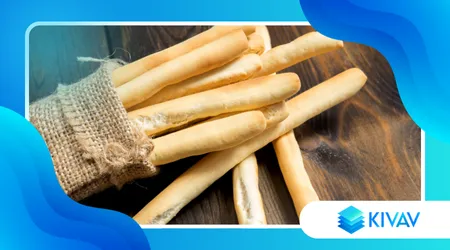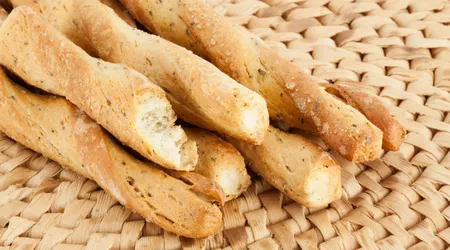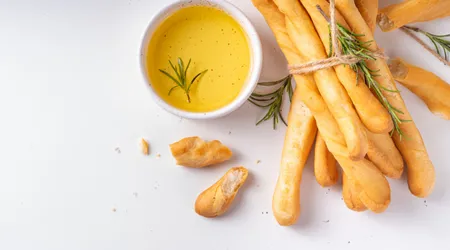Turin breadsticks: crunchy and light

THE Turin breadsticks, a symbol of Piedmontese bread making, embody lightness and crunchiness.
Announcements
Their history, intertwined with the Savoy nobility, still fascinates today. In 2025, these golden sticks remain the centerpieces of Italian tables, perfect for aperitifs or elegant dinners.
Their versatility makes them ideal with cured meats, cheeses, or sauces, while the simplicity of the ingredients enhances their authenticity.
In an age of rediscovery of traditions, the Turin breadsticks they shine as an emblem of taste and refinement.
This article explores their origins, artisanal process, modern variations, and their role in contemporary cuisine, offering practical insights and curiosities for lovers of good food.
Announcements
The Royal History of Turin's Grissini
In the 17th century, in Turin, the Turin breadsticksLegend has it that the doctor Teobaldo Pecchio created them for Vittorio Amedeo II, the young Duke of Savoy, who was in poor health.
The “ghersa”, a long Piedmontese bread, inspired these crunchy, crumb-free loaves, perfect for delicate digestion.
Napoleon, it is said, was so enamoured of it that he ordered regular transport from Turin to Paris. This royal story gives the Turin breadsticks a unique aura, which distinguishes them from other breads.
Their popularity grew rapidly, moving from noble courts to popular tables.
In 2025, the Turin breadsticks They are still a symbol of Turin, celebrated at food festivals such as the Salone del Gusto.
++ Pizza by the slice: how to prepare it
Their global fame is a testament to a legacy that endures. Every bite tells a story of tradition and innovation.
Despite their ancient origin, the Turin breadsticks they adapt to modern tastes.
Today, artisan bakeries offer them with sesame seeds, rosemary, or even chocolate, while maintaining the classic recipe as the beating heart.
Their versatility makes them a bridge between past and present, a food that unites generations.

The Art of Artisan Preparation
Create Turin breadsticks It's an art that requires patience and mastery. The basic recipe calls for flour, water, yeast, oil, and salt, but the secret lies in the preparation.
The soft and slightly elastic dough is rolled out and cut into thin strips. Hand-stretching, a traditional technique, gives them the elongated, irregular shape that makes them unique.
Baking at 190-200°C for 20-25 minutes ensures perfect crispiness.
According to research by Gambero Rosso (2023), the best bakeries in Turin use stone-ground flours to enhance the flavour.
See also: Soft buffet scones
This detail elevates the Turin breadsticks A product of excellence. The leavening process, often protected from drafts, prevents unwanted crusts.
Practical example: at the “Pane Felice” bakery in Turin, the dough rests in linen cloths to maintain moisture, a trick that guarantees light and crumbly breadsticks.
Try it at home: mix 500g of type 0 flour with 10g of fresh yeast and 30ml of oil, and let it rise for 90 minutes. Your kitchen will fill with the aroma.
Manual skill is crucial: stretching the dough without breaking it takes practice. An analogy?
It's like spinning wool: a fluid movement that transforms raw material into something precious.
This artisanal process makes each breadstick a small masterpiece, unique in shape and flavor.
Modern Variants and Creative Combinations
THE Turin breadsticks They're reinventing themselves in 2025, captivating palates with innovative variations. From the classic hand-rolled versions, they've moved on to whole wheat versions with turmeric, olives, or sun-dried tomatoes.
Some bakeries, like “Roberto Alimentare,” offer pink beetroot breadsticks, perfect for events like Valentine's Day.
These innovations respect tradition but give a nod to modernity.
Pairing them is a game of creativity. Try the breadsticks with chickpea hummus for a vegan appetizer, or with prosciutto for a contrasting flavor.
An original example: rosemary breadsticks with gorgonzola cream and walnuts, an explosion of flavor. Or crumble them over a pumpkin soup for added crunch.
The data confirms their success: in 2024, 65% of Turin restaurants included breadsticks in their bread baskets, according to a survey by Italia a Tavola.
Their lightness makes them ideal for balanced diets, with about 400 kcal per 100 g. But be careful: their crunchiness can tempt you to eat too many!
Why limit yourself to the classics? Experiment with sweet breadsticks with cinnamon and sugar, perfect with chocolate mousse.
Or use them as a base for a crunchy salad, crumbling them over arugula and feta. The versatility of breadsticks invites you to be daring, without betraying their essence.
The Role of Breadsticks in Contemporary Cuisine
In a world that celebrates fast food, the Turin breadsticks They represent a gentle resistance. They are the antithesis of industrial bread: artisanal, authentic, and tied to the local area.
In Turin's starred restaurants, like "Del Cambio," they accompany sophisticated dishes, demonstrating that simplicity can be refined. Their presence is a tribute to Piedmontese tradition.
Not just restaurants: breadsticks are conquering home aperitifs. In 2025, with the increase in post-pandemic social events, they are the protagonists of buffets and dinners with friends.
An example? Breadsticks wrapped in speck with a glass of Barolo: elegance in a single gesture. Their practicality makes them perfect for any occasion.
But what is their true power? They foster conviviality. A basket of breadsticks invites sharing, chatting, and slowing down.
In a fast-paced age, this is a luxury. Try offering them at a dinner party: you'll notice how guests relax, breaking the ice with a crispy bite.
Sustainability is another strength. Many bakeries use organic and local flours, reducing their environmental impact.
This aligns breadsticks with the trends of 2025, where food is also an ethical choice. Choosing artisanal breadsticks means supporting small businesses and centuries-old traditions.
Turin Breadsticks and the Future of Breadmaking

Looking to the future, the Turin breadsticks They are confirmed as a timeless product. In 2025, interest in artisanal foods is growing, and breadsticks are the answer to this demand.
Bakeries like "Spoto" in Turin are experimenting with ancient grains, such as Sicilian Perciasacchi, to make even more digestible and flavorful breadsticks.
This innovation respects the Piedmontese roots.
New generations are rediscovering them thanks to social media. On Instagram, food bloggers like "MangiaTorino" share homemade breadstick recipes, inspiring thousands of followers.
This digital revival proves that tradition can be trendy. Try posting your breadsticks: the likes will come!
Globalization takes them far and wide. In Japan, breadsticks are served in upscale izakayas, while in New York they accompany cheeseboards.
Yet their heart remains in Turin. Supporting local producers means preserving a cultural heritage that makes Italy unique.
Finally, breadsticks teach a lesson: simplicity wins. In a world of excess, a stick of bread can be enough to create a perfect moment.
The next time you break one, think about the story it carries: it's a journey spanning centuries.
Table: Nutritional Values of Turin Breadsticks (per 100 g)
| Nutritious | Amount |
|---|---|
| Calories | 400 kcal |
| Carbohydrates | 75 g |
| Proteins | 10 g |
| Fats | 8 g |
| Fibers | 3 g |
| Sodium | 1.5 g |
Conclusion: A Heritage to Savour
THE Turin breadsticks They're more than just bread: they're a symbol of Turin, a bridge between past and future. Their crunchiness and lightness are captivating, while their royal history captivates.
In 2025, they continue to bring people together, from Michelin-starred restaurants to home cooks. Preparing them at home or choosing artisanal ones is a gesture of love towards tradition.
Every bite is an invitation to slow down, share, and savor. They're more than just food: they're an experience. What will be the next pairing you'll try with your breadsticks?
Experiment, and let the magic of Piedmont inspire you.
Frequently Asked Questions
1. How to store Turin breadsticks to keep them crunchy?
Store them in an airtight container or paper bag, away from moisture. They last up to 3 days, but are best eaten fresh.
2. Can I make Turin breadsticks without yeast?
Yes, you can use self-rising flour or baking soda, but the texture will be less traditional. For authentic results, fresh yeast is recommended.
3. Which flours are ideal for Turin breadsticks?
Type 0 or 00 flour for the classic version. Whole grain flours or ancient grains, such as spelt, add flavor and digestibility.
4. Are Turin breadsticks suitable for vegan diets?
The basic recipe is vegan (flour, water, oil, yeast, salt). Make sure any variations containing seeds or flavorings do not contain animal products.
